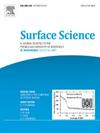Methanol adsorption and dissociation on GaP(110) studied by ambient pressure X-ray photoelectron spectroscopy
IF 2.1
4区 化学
Q3 CHEMISTRY, PHYSICAL
引用次数: 0
Abstract
Ambient pressure X-ray photoelectron spectroscopy (AP-XPS) was used to investigate methanol (CH3OH) adsorption and reaction on the GaP(110) surface. Exposure of CH3OH to GaP(110) at room temperature led to the formation of at least four different surface species as indicated by analysis of C 1s and O 1s XPS features. By combining AP-XPS data with density functional theory calculations, the surface species were identified as methoxy (CH3O*), formaldehyde (CH2O*), and paired methanol (p-CH3O*H) and methoxy (p-CH3O*) species, where “paired” means that they belong to a hydrogen-bonded methoxy-methanol complex. Asterisk * here indicates an adsite. The formation of CH2O* via the dehydrogenation of CH3O* was shown to be limited by the availability of vacant phosphorus (P) sites on GaP(110). With an increase in CH3OH pressure, the fractional coverage of CH3O* species reached 0.55, and the surface P sites were completely saturated with hydrogen. Under a constant CH3OH pressure of 0.5 Torr, the surface concentration of the paired species and of CH2O* remained constant until 400 K. At higher temperatures, thermally driven reactions led to a significant increase in the concentration of surface CHx* species, which suggests that C-O bond cleavage of the CH3O group is the dominant decomposition mechanism on GaP(110). Based on the reactivity of GaP(110) toward CH3OH dehydrogenation, elevated temperatures and CH3OH pressures may be used to functionalize this surface.

用环境压力x射线光电子能谱研究了甲醇在GaP(110)上的吸附和解离
采用环境压力x射线光电子能谱(AP-XPS)研究了甲醇(CH3OH)在GaP(110)表面的吸附和反应。根据c1s和o1s的XPS特征分析,室温下CH3OH暴露于GaP(110)中可形成至少四种不同的表面物质。将AP-XPS数据与密度泛函理论计算相结合,确定表面物质为甲氧基(ch30 *)、甲醛(CH2O*)、甲醇(p- ch30 *H)和甲氧基(p- ch30 *),其中“成对”表示它们属于一个氢键的甲氧基-甲醇配合物。此处的星号*表示网站。通过ch30 *脱氢生成CH2O*被证明受到GaP上空位磷(P)位点可用性的限制(110)。随着CH3OH压力的增加,ch30 *物质的分数覆盖率达到0.55,表面P位被氢完全饱和。在恒定的CH3OH压力0.5 Torr下,配对物质和CH2O*的表面浓度保持恒定,直到400 K。在较高的温度下,热驱动反应导致表面CHx*的浓度显著增加,这表明ch30基团的C-O键裂解是GaP的主要分解机制(110)。根据GaP(110)对CH3OH脱氢的反应活性,可以使用高温和CH3OH压力来功能化该表面。
本文章由计算机程序翻译,如有差异,请以英文原文为准。
求助全文
约1分钟内获得全文
求助全文
来源期刊

Surface Science
化学-物理:凝聚态物理
CiteScore
3.30
自引率
5.30%
发文量
137
审稿时长
25 days
期刊介绍:
Surface Science is devoted to elucidating the fundamental aspects of chemistry and physics occurring at a wide range of surfaces and interfaces and to disseminating this knowledge fast. The journal welcomes a broad spectrum of topics, including but not limited to:
• model systems (e.g. in Ultra High Vacuum) under well-controlled reactive conditions
• nanoscale science and engineering, including manipulation of matter at the atomic/molecular scale and assembly phenomena
• reactivity of surfaces as related to various applied areas including heterogeneous catalysis, chemistry at electrified interfaces, and semiconductors functionalization
• phenomena at interfaces relevant to energy storage and conversion, and fuels production and utilization
• surface reactivity for environmental protection and pollution remediation
• interactions at surfaces of soft matter, including polymers and biomaterials.
Both experimental and theoretical work, including modeling, is within the scope of the journal. Work published in Surface Science reaches a wide readership, from chemistry and physics to biology and materials science and engineering, providing an excellent forum for cross-fertilization of ideas and broad dissemination of scientific discoveries.
 求助内容:
求助内容: 应助结果提醒方式:
应助结果提醒方式:


